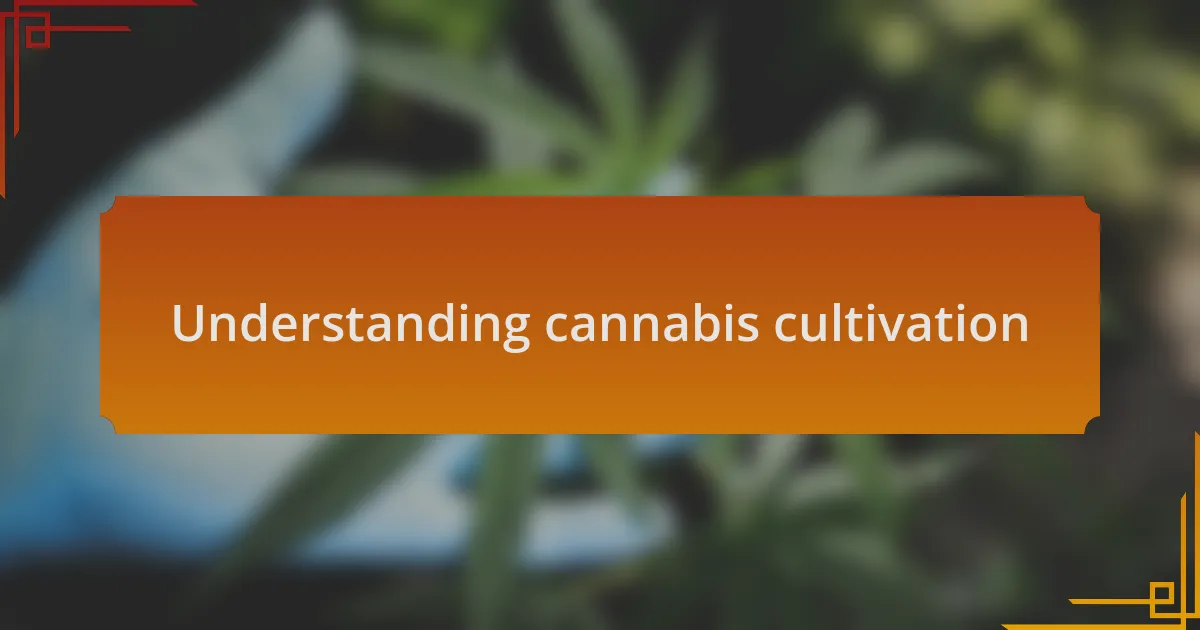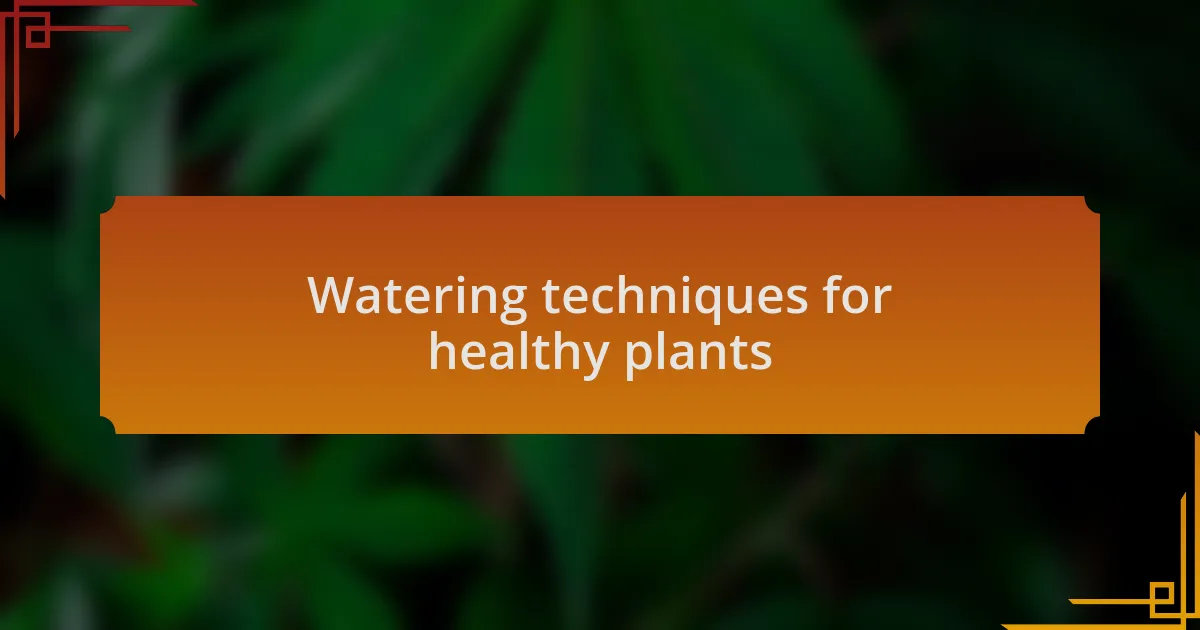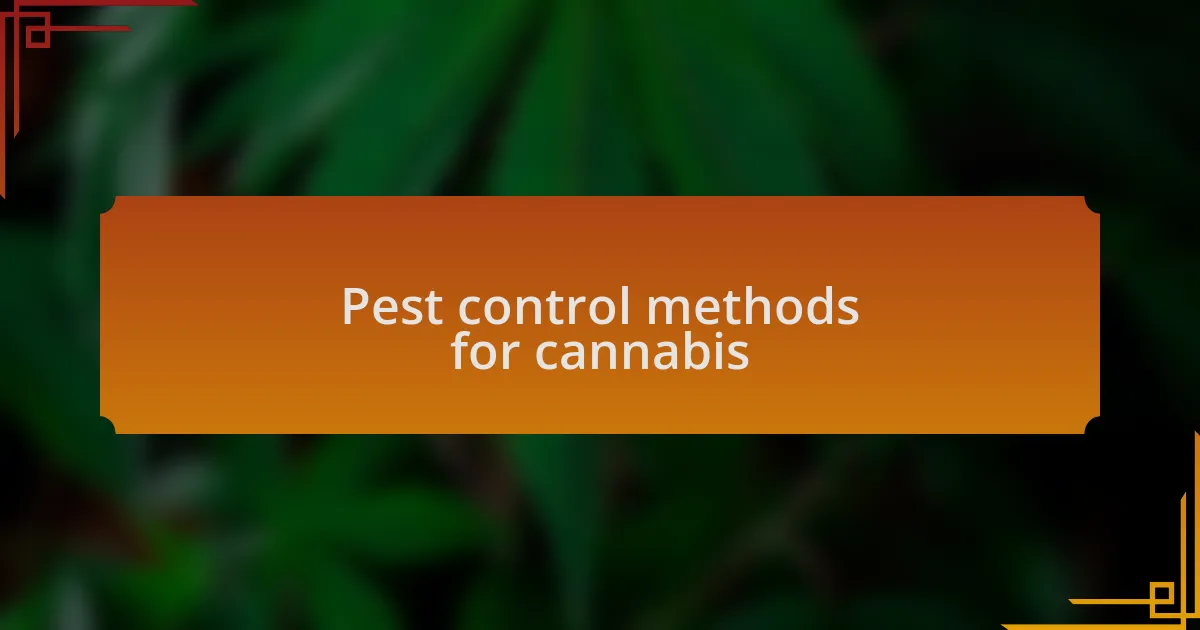Key takeaways:
- Optimal cannabis growth depends heavily on light exposure, stable temperatures (70-85°F), and appropriate humidity (40-60%).
- Choosing the right cannabis strain influences growth behavior, pest resistance, and alignment with personal needs.
- Balanced nutrient intake, including macronutrients and micronutrients, along with proper pH levels, is essential for healthy plant development.
- Effective pest control methods include introducing beneficial insects, using organic sprays like neem oil, and maintaining a clean growing environment.

Understanding cannabis cultivation
Understanding the intricacies of cannabis cultivation is essential for any grower who wants their plants to flourish. I still remember my first attempt at growing; I was overly eager but underestimated how crucial the right environment is. Did you know that light, temperature, and humidity levels dramatically affect growth? It’s like creating a perfect habitat where your plants can truly thrive.
To cultivate cannabis effectively, I often consider the significance of soil quality. I learned the hard way that not all soil is created equal after a batch of my seedlings struggled to take root. It made me realize that investing time in choosing the right organic soil blend could mean the difference between a mediocre harvest and a bountiful one. Have you ever felt that relationship with your plants, where you just know when something isn’t quite right?
Nurturing cannabis isn’t just about providing nutrients; it’s about listening to your plants. There have been times when my plants displayed signs of stress, and I had to troubleshoot quickly. It’s fascinating how these living organisms communicate their needs—whether it’s too much or too little water or nutrient deficiencies. Each day spent observing them feels like a rewarding exploration, reminding me just how delicate and incredible the life cycle of cannabis truly is.

Essential growing conditions
Ensuring the right light exposure is one of the most critical factors for cannabis growth. I remember the first time I used a grow light—what a game changer! At first, I thought I could just use sunlight, but shifting to the right spectrum of artificial light opened up a world of possibilities for my plants. Have you noticed how they seem to reach for the light? It’s a reminder that they are striving for their best selves, much like us.
Temperature control is equally vital for healthy cannabis plants. Early on, I had a few surprises with fluctuating night-time temperatures. I learned that keeping conditions stable, ideally between 70-85 degrees Fahrenheit during the day, helps prevent stress and ensures consistent growth. It made me wonder how often we overlook the impact of our environment on our well-being, just as these plants rely on us for stability.
Humidity plays a significant role in the overall health of the plants as well. I’ll never forget when my mini-forest thrived during the humid summer but struggled in the dry winter air. Maintaining humidity levels around 40-60% really helped my plants breathe and develop properly. Have you ever experienced that sense of helplessness when conditions aren’t ideal? It’s a wake-up call that constantly urges me to adapt and learn, and it showcases the very essence of being a caring grower.

Choosing the right cannabis strain
Choosing the right cannabis strain is crucial for cultivating happy and bountiful plants. When I first started growing, I was overwhelmed by the sheer variety available. After much trial and error, I found that strains can vary significantly in terms of growth behavior, resistance to pests, and flavor profiles. Have you ever felt that excitement when you discover a strain that perfectly fits your growing environment and personal preferences? It’s a game changer.
I remember my first encounter with a high-CBD strain; the calming effects were soothing and comforting. The right strain can align not only with your climate but also with your personal needs. Strains like ‘Blue Dream’ or ‘Girl Scout Cookies’ can offer unique benefits—for instance, energy versus relaxation. It’s about finding the right match, much like choosing the ideal partner for a dance.
Also, considering the flowering time of a strain is essential. Some strains can flower in as little as eight weeks, while others may take up to fourteen weeks. I once grew a strain that felt like it took forever to mature, testing my patience and dedication. Have you experienced that anticipation waiting for your plants to bloom? It’s a lesson in resilience and hope, reminding me that good things truly come to those who wait.

Nutrient requirements for cannabis
Cannabis plants have specific nutrient needs to thrive, particularly during their vegetative and flowering stages. From my experience, the right balance of macronutrients—nitrogen, phosphorus, and potassium—is crucial. For instance, during the vegetative phase, I focus heavily on nitrogen, as it fuels healthy leaf and stem growth. Have you ever noticed how vibrant green leaves look after a good nutrient boost? It’s like watching life spring forth in your garden.
Micronutrients shouldn’t be overlooked either. Calcium and magnesium play vital roles in cell structure and overall plant health. I learned this the hard way when I neglected these elements. My plants exhibited signs of nutrient deficiency, and it was a stark reminder that even small factors can dramatically affect growth. Have you ever seen leaves curling or turning yellow? Those can be telltale signs that your plants might need a little extra care with their micronutrients.
I also recommend monitoring pH levels in your nutrient solution. I remember a time when I didn’t pay attention to pH, and it resulted in nutrient lockout. Plants may struggle to absorb essential nutrients effectively when the pH is off. Maintaining a pH of around 6.0 to 6.5 for soil and 5.5 to 6.0 for hydroponics has helped me achieve healthy, productive plants. Isn’t it fascinating how sometimes the simplest adjustments can lead to thriving gardens?

Watering techniques for healthy plants
Watering your cannabis plants is one of the most crucial aspects of their care, and I’ve learned that morning is the best time to do it. By watering early, the plants can soak up moisture before the heat of the day causes evaporation. I recall the first time I watered in the morning; I was amazed at how fresh and vibrant my plants looked throughout the day. Has that ever happened to you, seeing your hard work pay off so visibly?
I also emphasize the importance of deep watering. Initially, I used to water only the surface, but this led to shallow root systems. When I switched to soaking the soil thoroughly and allowing it to drain, my plants began to thrive much more robustly. Deep roots mean healthier plants, and watching them grow stronger made me rethink my watering strategy entirely. It’s like having a solid foundation for a house—you want to ensure it’s built to last.
Additionally, I’ve found that the frequency of watering can vary based on the growth stage of the plant and environmental factors. For younger plants, I water more frequently in smaller amounts, while mature plants can go longer between watering sessions. A memorable moment was when I realized the soil’s weight was a good indicator for me; when it felt too light, it was a sign that it was time to water again. Have you ever sensed that perfect balance between the soil and your plants? It’s truly rewarding when you can gauge their needs just by touch.

Pest control methods for cannabis
One of the most effective pest control methods I’ve found for cannabis is introducing beneficial insects. Ladybugs, for example, are incredible little allies against aphids and other pests. I still remember the first time I released them in my garden; it felt like inviting a brigade of tiny superheroes to protect my plants. Have you ever noticed how nature has its ways of balancing itself out?
In addition to beneficial insects, I’ve had great success with organic sprays. Neem oil is a favorite of mine because it disrupts the life cycle of pests without harming the plant. There was a phase when I faced a spider mite invasion, and after a few applications of neem oil, those little critters were gone. It was a relief to see my plants regain their health. Have you ever felt that sense of triumph when you find a solution that works?
I also swear by keeping a clean growing environment to prevent pests from taking hold. Regularly removing debris, pruning dead leaves, and maintaining proper airflow have been key for me. One time, I neglected this routine, and before I knew it, pests started to appear. It was a wake-up call that reminded me how crucial diligence is in pest management. Does your growing area have that same level of care? It truly makes a difference.